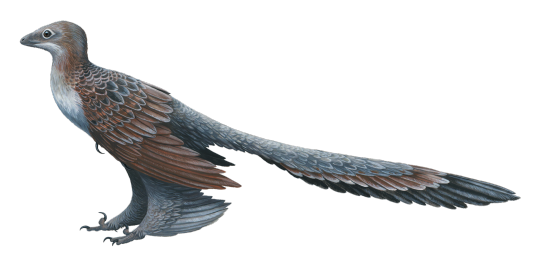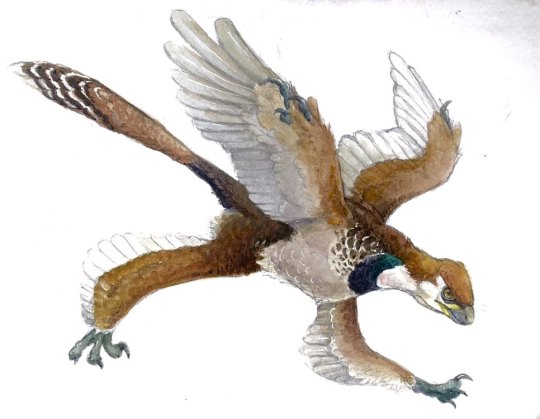#Changyuraptor yangi feathers
Explore tagged Tumblr posts
Text
Changyuraptor yangi

By Scott Reid
Etymology: Long Feathered Robber
First Described By: Han et al., 2014
Classification: Dinosauromorpha, Dinosauriformes, Dracohors, Dinosauria, Saurischia, Eusaurischia, Theropoda, Neotheropoda, Averostra, Tetanurae, Orionides, Avetheropoda, Coelurosauria, Tyrannoraptora, Maniraptoromorpha, Maniraptoriformes, Maniraptora, Pennaraptora, Paraves, Eumaniraptora, Dromaeosauridae, Microraptoria
Status: Extinct
Time and Place: About 124.4 million years ago, in the Aptian of the Early Cretaceous


Changyuraptor is known from the Dawangzhangzi Bed of the Yixian Formation

Physical Description: Changyuraptor was a medium sized dinosaur, about 1.2 meters long - something like a modern turkey in terms of weight. It was covered from head to toe in feathers, including full wings on its arms, a large tail fan, and wings on its legs. It had a small, pointy head and long tail, while its body was fairly stocky. It also had sharp claws on its hands and sickle claws on its feet, like other raptor-dinosaurs. It’s tail was so long and feathered - with feathers reaching up to 30 centimeters in length and being the largest feathers known in a non-avian dinosaur - it would have allowed for softer landings for Changyuraptor. In short, it was probably the largest and fluffiest four-winged dinosaur known.
Diet: Changyuraptor would have primarily fed upon small animals like mammals, lizards, and amphibians.

By Emily Willoughby, CC BY-SA 4.0
Behavior: Like Microraptor, Changyuraptor was probably capable of flight, making it one of the largest flying dinosaurs of the Mesozoic Era - with very few birds ever growing larger than it. It wouldn’t have been a particularly good flier though, only about as well as a chicken, taking off clumsily from the ground to go from area to area. It didn’t have enough strength in the chest and wing muscles to do much more than this, though it’s possible the hindlimb feathers would have allowed for some maneuvering in the air. It then could pounce on its prey, using its sickle claw to hold onto struggling animals before eating them.
More importantly; the wings, tail fan, and leg wings would have all been good display structures for Changyuraptor, which would have used them to communicate with other members of the species. These feathers would have signaled anger, a desire to mate, or danger, as feathers today are used by birds. It’s probable, then, that at least some fancy coloration may have been present on Changyuraptor to aid in the communication. Changyuraptor would have been a very active animal and most likely would have taken care of its young. In fact, it may have used its variety of wings and fans to help brood the nest.
Ecosystem: Changyuraptor lived in the Yixian Formation, a highly diverse ecosystem showcasing the evolution of birdie dinosaurs - like Changyuraptor - at the beginning of the Cretaceous period. A temperate, seasonal, and humid climate, it was much like the modern day northwestern Pacific Coast, though it would have seen snow on a regular basis, as well as notable dry seasons. It was a diverse coniferous forest, with a variety of flowering plants, ferns, horsetails, ginkgoes, cycads, seed ferns, and many others. Changyuraptor would have probably spent most of its time in the trees as well as on the ground, given its flight ability. There were a lot of freshwater lakes, and abundant volcanic eruptions.

By Ripley Cook
Changyuraptor lived along so many other kinds of dinosaurs, it’s almost impossible to list them all. There were ankylosaurs like Liaoningosaurus and ornithopods like Bolong and Jinzhousaurus. There was the larger Compsognathid Sinosauropteryx, as well as many raptors in addition to Changyuraptor like the large Zhenyuanlong, Sinornithosaurus, and Tianyuraptor. There was also the Troodontid Jianianhualong, the seed eating protobird Jeholornis, smaller protobirds like Confuciusornis and Zhongornis, and the Anchiornithid Yixianosaurus. Opposite birds were there too like Dalingheornis and Shanweiniao, as well as near-birds like Archaeorhynchus, Eogranivora, Yanornis, Hongshanornis, and Longicrusavis. Non-dinosaurs like fish, amphibians, and lizards were also there; they along with mammals like Akidolestes, Sinobaatar, Sinodelphys, Chaoyangodens, and Eomaia would have been the primary prey of Changyuraptor. There were also Choristoderes like Hyphalosaurus and Monjurosuchus, as well as pterosaurs like Cathayopterus and Ningchengopterus. In short, a fascinating snapshot of Early Cretaceous life.
Other: Changyuraptor was closely related to - and preceded - Microraptor, one of the best known feathered dinosaurs; though we don’t know if it would have been colored like Microraptor, it’s possible it may have also had iridescent feathers like its later relative.
~ By Meig Dickson
Sources under the Cut
Amiot, R., X. Wang, Z. Zhou, X. X. Wang, E. Buffetaut, C. Lécuyer, Z. Ding, F. Fluteau, T. Hibino, N. Kusuhashi, J. Mo, V. Suteethorn, Y. Y. Wang, X. Xu, F. Zhang. 2011. Oxygen isotopes of East Asian dinosaurs reveal exceptionally cold Early Cretaceous climates. Proceedings of the National Academy of Sciences 108 (13): 5179 - 5183.
Benson, R.B.J. & Brussatte, S. (2012). Prehistoric Life. London: Dorling Kindersley. p. 332.
Choi, Charles (15 July 2014). "Bizarre Dinosaur Had 4 'Wings,' Long Tail Feathers". LiveScience.com. Retrieved 16 July 2014.
Gang Han; Luis M. Chiappe; Shu-An Ji; Michael Habib; Alan H. Turner; Anusuya Chinsamy; Xueling Liu & Lizhuo Han (15 July 2014). "A new raptorial dinosaur with exceptionally long feathering provides insights into dromaeosaurid flight performance". Nature Communications. 5: 4382.
Iacurci, Jenna (15 July 2014). "New Four-Winged Dinosaur Built for Flight". Nature World News. Retrieved 16 July 2014.
Larsson, Hans, Hone, David, Dececchi, T. Alexander, Sullivan, Corwin, Xu, Xing. "THE WINGED NON-AVIAN DINOSAUR MICRORAPTOR FED ON MAMMALS: IMPLICATIONS FOR THE JEHOL BIOTA ECOSYSTEM" "Program and Abstracts. 70th Anniversary Meeting Society of Vertebrate Paleontology October 2010" 114A.
Meng, F.X.; Gao, S.; Liu, X.M. (2008). “U-Pb zircon geochronology and geochemistry of volcanic rocks of the Yixian Formation in the Lingyuan area, western Liaoning, China”. Geological Bulletin of China. 27: 364–373.
Morgan, James (16 July 2014). "Four-winged dinosaur is 'biggest ever'". BBC News. Retrieved 16 July 2014.
Naish, Darren (2012). Planet Dinosaur: The Next Generation of Killer Dinosaurs. Firefly Books. p. 186.
Nicholas R. Longrich; David M. Martill; Brian Andres (2018). "Late Maastrichtian pterosaurs from North Africa and mass extinction of Pterosauria at the Cretaceous-Paleogene boundary". PLOS Biology. 16 (3): e2001663.
Pickrell, John (16 July 2014). "Four-winged dinosaur had record-breaking tail feathers". Australian Geographic Society. Retrieved 16 July 2014.
Wang, Y., S. Zheng, X. Yang, W. Zhang, Q. Ni. 2006. The biodiversity and palaeoclimate of confier floras from the Early Cretaceous deposits in western Liaoning, northeast China. International Symposium on Cretaceous Major Geological Events and Earth System: 56A.
Zhou, Z. 2006. Evolutionary radiation of the Jehol Biota: chronological and ecological perspectives. Geological Journal 41: 377-393.
#Changyuraptor#Changyuraptor yangi#Dromaeosaur#Raptor#Dinosaur#Bird#Birds#Dinosaurs#Feathered Dinosaurs#Paleontology#Prehistoric Life#Prehistory#Birblr#Palaeoblr#Factfile#Carnivore#Eurasia#Theropod Thursday#Cretaceous
264 notes
·
View notes
Photo


ah, its my fav, that little dude with four wings
#changyuraptor yangi#changyuraptor#raptor#dinosaur#birb#bird#art#digital art#hexel art#little dude had...........4 (four) wings#adorable#and looked like a crow#imagine that#the best birb ever#tied for best with sinosauropteryx of course#which i will draw also because they're basically the fox of the cretaceous#these two are 2 dinos that have had feather colour and pattern confirmed#i love dinosaurs
27 notes
·
View notes
Text

Another Microraptorian from Cretaceous China, Changyuraptor yangi was the largest four-winged dinosaur known and possibly the largest non-avialan dinosaur capable of flight. It was around 1.2 metres (3.9 ft) long, most of which is attributed to its long tail feathers, and was about as tall as a turkey.
79 notes
·
View notes
Text
VIDEO: Largest 'Four-Winged' Dinosaur To Date Unearthed In China
VIDEO: Largest ‘Four-Winged’ Dinosaur To Date Unearthed In China
Scientists have discovered what they say is the largest-known feathered dinosaur, and its fossil could provide new insight into prehistoric flight.
(more…)
View On WordPress
#Changyuraptor yangi#Changyuraptor yangi feathers#Changyuraptor yangi fossil#feathered dinosaur#four winged dinosaur#four winged dinosaur china#largest feathered dinosaur#newsy#science news
0 notes